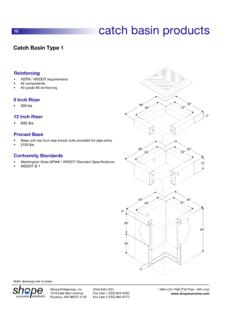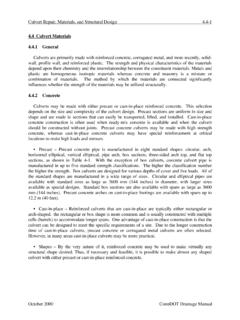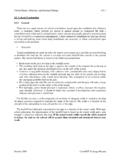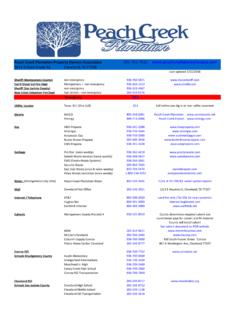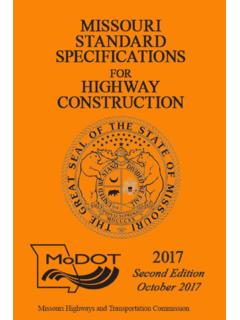Transcription of CONCRETE PIPE BOX CULVERT INSTALLATION
1 CONCRETE pipe & BOX CULVERTINSTALLATION American CONCRETE pipe Association American CONCRETE pipe Association Table of ContentsI. CONCRETE pipe INSTALLATION 5 6 Ordering, Receiving And 10 12 Line And 12 Excavation 17 Excavated 19 Standard 20 Class A 27 Class B 27 Class C 28 Class D 38 38 42 Geotextile Filter 43 External 43 Joint 46 Curved 46 Final 50 Acceptance 50 Soil 51 Line And 52 Visual 56 Air 58 Vacuum 61 American CONCRETE pipe Association Joint 62 Joint 62II.
2 BOX CULVERT INSTALLATION 64 65 Ordering, Receiving & 65 Scheduling / Unloading / Placing / 67 SITE 70 70 73 Box 73 Box 73 Connecting the 76 Minimum Cover For Construction 77 Visual 78 III. SPECIFICATIONS ..79 IV. 87 Feet Head of Water into Pressure, Pounds Per Square Head of Water into Kilopascals (kN/m2)..90 American CONCRETE pipe Association I. CONCRETE pipe INSTALLATION MANUALINTRODUCTIONThis manual presents a guide for the proper in-stallation of CONCRETE pipe .
3 For many years, the American CONCRETE pipe Association has conduct-ed comprehensive research and analysis of the factors which affect the field performance of con-crete pipe . The knowledge and beneficial practices gained through research and experience are pre-sented in this focusing on the construction of the pipe -soil system, this manual also addresses those fac-tors critical to the completion of the entire system, from delivery of the CONCRETE pipe to the jobsite, to the acceptance of the installed manual is intended as a guide and is not to supersede the project specifications.
4 American CONCRETE pipe Association PRE-CONSTRUCTIONPRECAUTIONSF ederal regulations covering safety for all types of construction, including sewer and CULVERT instal-lations, are published in the Safety and Health Reg-ulations for Construction under the Department of Labor, Occupational Safety and Health Administra-tion (OSHA). These regulations are applicable to all prime contractors and subcontractors involved in any type of construction, including alterations and repair installer should also review INSTALLATION prac-tices with the engineer s design assumptions, par-ticularly in relation to the use of trench boxes and compaction requirements of the , RECEIVING AND HANDLINGA lthough the ordering of materials is the contrac-tor s responsibility.
5 Supplier and engineer familiarity with the contractor s proposed schedule will en-able better coordination to avoid mistakes and pos-sible delays in pipe deliveries. pipe manufactur-ers stock a wide range of pipe sizes and strengths, but production facilities must frequently be adapted to meet specific project requirements, particularly when large quantities and/or special types of pipe are involved. Information required to initiate a pipe order should be in writing and include:name and location of project pipe size, laying length and strengthtotal footage of each type and size of pipe type of jointsize and quantity of manhole base sections, riser sections, cone sections and grade ringslist of fittings and specials including radius pipe American CONCRETE pipe Association laying sequencerequired specificationsmaterial test requirementsjoint material and quantityinvoicing instructionsThe pipe should be checked for the following in-formation, clearly marked on each pipe section.
6 Specification designationpipe class or strength designationspan, rise, table number, top of box and de-sign earth cover for ASTM C 1433(M) or C 1577(M), or AASHTO M259(M) or M273(M) box sectionsdate of manufacturename or trademark of the manufacturerfor reinforced pipe with elliptical or quadrant reinforcement orientation, the letters E or Q, respectively and top .UNLOADINGU nloading of pipe should be coordinated with the construction schedule and INSTALLATION sequence to avoid re-handling and unnecessary equipment movement.
7 Access to the jobsite shall be provided by the contractor to ensure that the pipe manufac-turer s trucks can deliver pipe to the unloading area under their own shipment of pipe is loaded, blocked and tied down at the plant to avoid damage during tran-sit. However, it is up to the receiver to make cer-tain, damage has not occurred in delivery from the plant to the construction site. An overall inspection of each pipe shipment should be made on arrival, before the pipe is unloaded. Total quantities of each item should be checked against the delivery slip and any damaged or missing items recorded on American CONCRETE pipe Association AUTOMATIC UNLOADERthe delivery a pipe is damaged during delivery or unload-ing, the pipe should be set aside.
8 Damaged ends, chips or cracks, which do not pass through the wall, can usually be carriers are equipped with automatic un-loaders, which further expedite the unloading of cir-cular pipe . These automatic unloaders consist of a forklift type of apparatus mounted at the rear of a flat bed truck. The forks rotate vertically rather than move up and down, such that, when the forks are in a vertical position they extend above the truck bed. This provides a backstop and cushion for the pipe sections as they are rolled to the rear of the truck for unloading.
9 A cradle formed by the forks and unloader frame securely retains the pipe section being unloaded as the forks are rotated downward and lowered to the of the pipe should be controlled so as not to collide with the other pipe sections or fittings, and care should be taken to avoid chipping or spall-ing, especially to the spigots and bells. Caution should be exercised to be sure personnel are out of American CONCRETE pipe Association the path of the pipe as it is the pipe has to be moved after unloading, the sections should be rolled or lifted and should never be dragged.
10 pipe sections should not be rolled over rough or rocky use of mechanical equipment is necessary for unloading arch, elliptical and box sections and larger size circular pipe , and can usually simplify and speed up the unloading of smaller pipe . When using mechanical equipment for unloading, the lifting device, which connects to the pipe , should enable proper and safe handling without damage to the pipe . Lifting devices such as slings, chain, steel wire, cable and rope should be placed around the pipe and arranged so that the pipe is lifted in a horizontal position.
